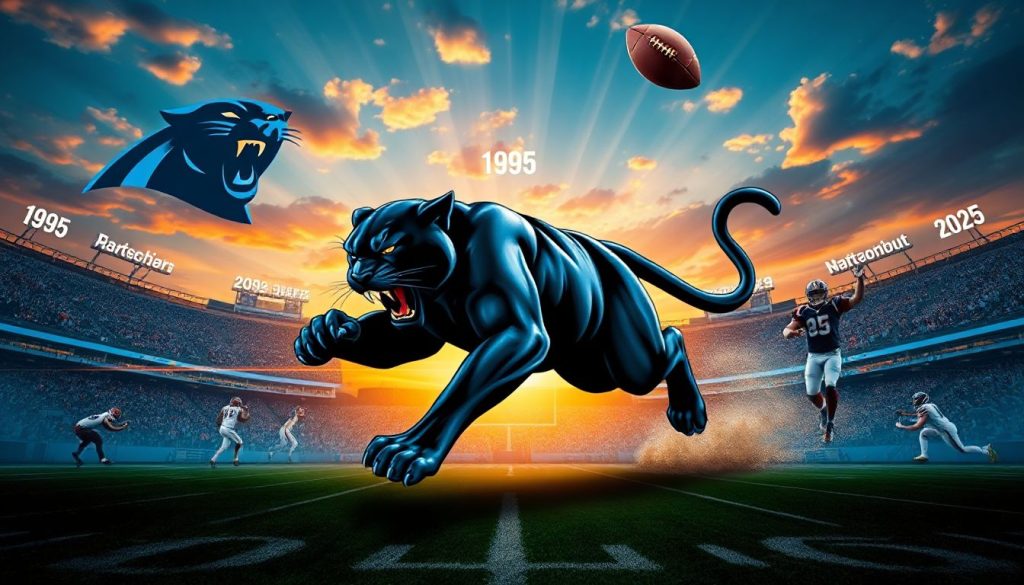Since debuting in 1995, the Carolina Panthers have carved out a bold spot in NFL history. From humble beginnings, they’ve developed into a team known for fierce competition and passionate fans. Over three decades, they’ve faced ups and downs, enjoyed glory, and learned tough lessons. Tracking this journey helps fans get more connected and offers key insights for sports analysts looking to understand the team’s evolution. The Panthers’ story is proof that perseverance and strong community ties can turn dreams into reality.
The Birth and Early Years of the Carolina Panthers (1995–2000)
Expansion and Inauguration
The Carolina Panthers started with big dreams when they officially joined the NFL in 1995. Born from the NFL’s effort to expand teams and bring football to new markets, they drew attention quickly. Founders focused on creating a unique identity, hiring passionate staff, and building a team roster with promising young players. Their first logo combined a fierce panther head with a bold wordmark that set the tone. Early marketing emphasized regional pride, helping to grow a fan base eager for NFL action in the Carolinas.
Struggles and Growth
Like many new teams, the Panthers faced tough times initially. The early seasons brought more losses than wins, but every game built experience. Key players, like quarterback Kerry Collins and linebacker Kevin Greene, provided sparks of hope. Head coaches Dom Capers and George Seifert worked to instill discipline and a strong locker-room culture. Community outreach programs were launched to keep fans engaged and foster loyalty in tough early seasons. Though progress was slow, these roots laid a foundation for future growth.
Early Milestones
The Panthers made history in 1996 with their first playoff appearance, a huge confidence boost. In the NFC Divisional Round, they stunned the Dallas Cowboys before falling to the Green Bay Packers in the NFC Championship. These early moments set the stage for a team that refused to give up. Fans started rallying around the Panthers’ grit and determination, eager to see more victories and meaningful playoff runs in the seasons ahead.

The Rise to Contenders: The 2000s and Early 2010s
Building a Competitive Squad
The 2000s saw the Panthers bolster their roster with key draft picks and savvy trades. Julius Peppers emerged as one of the most fearsome defensive ends in the league, transforming opponents’ offensive strategies. Wide receiver Steve Smith became a staple for big plays and leadership on the field. Head coach John Fox brought a no-nonsense approach, emphasizing discipline and tough defense. These moves made the Panthers more competitive and solidified their place as playoff contenders.
Notable Playoff Runs
In 2003, the Panthers reached Super Bowl XXXVIII, marking a major milestone in franchise history. Led by quarterback Jake Delhomme and a resilient defense, they pushed the New England Patriots to the limit, ultimately losing 32–29 in a nail-biting finish. The game solidified Carolina’s reputation as a fierce competitor.
Franchise Growth and Fan Engagement
Throughout these years, the Panthers’ fan base grew rapidly. Tarheel and southern pride fueled enthusiasm. The team expanded its community programs, supporting charities and youth sports. This helped deepen their roots, making the Panthers not just a team, but a pillar of regional identity. As media coverage increased, so did their visibility, helping attract more fans and sponsors.
The Peak Years: Super Bowl 50 and Newton Era

The 2015 Season: Reaching Super Bowl 50
The 2015 season was a historic one for the Panthers. Led by MVP quarterback Cam Newton, the team rolled through the regular season with a 15-1 record. Star linebacker Luke Kuechly anchored a tough defense that conceded few points. Their playoff journey was thrilling, edging out the Seahawks and Cardinals in key battles. The Super Bowl 50 appearance against the Denver Broncos brought intense excitement, but unfortunately resulted in a loss. Still, reaching the big game proved the Panthers could compete with the NFL’s elite.
Post-Super Bowl Performance
After their Super Bowl run, the Panthers faced hurdles. Injuries and roster changes challenged their consistency. Cam Newton battled injuries and eventually moved on. Luke Kuechly retired in 2020 due to health concerns, leaving a leadership void. Coaching changes and front office turnovers added to the challenge. Despite the setbacks, the franchise kept pushing forward, always looking for ways to bounce back stronger.
The Modern Era: 2020s to 2025

Rebuilding and Young Talent
Since 2020, the Panthers have focused heavily on rebuilding through the NFL Draft and free agency. Key additions include young players like Jaycee Horn, Ikem Ekwonu, and wide receiver Jonathan Mingo. The franchise took a big step by drafting quarterback Bryce Young as the No. 1 overall pick in 2023, signaling a commitment to long-term success. His development will be crucial as the Panthers look to regain playoff form.
New Coaching and Management Vision
The team brought in Frank Reich in 2023 to guide this rebuild but moved on quickly after a disappointing start. In 2024, Dave Canales was hired as head coach, bringing optimism and a fresh offensive mindset. His partnership with Bryce Young aims to develop a winning culture. General Manager Dan Morgan, promoted in 2024, emphasizes smart roster moves and cultural stability.
Fan Engagement and Stadium Experience
Panthers fans remain loyal and passionate. The team continues to invest in fan experience at Bank of America Stadium and deepen digital engagement through social media and exclusive content. Community initiatives such as “Keep Pounding Day” and youth development programs strengthen their identity and bond with Charlotte and the Carolinas.
Challenges and Resilience in a Changing NFL Landscape
Adapting to League Trends
Modern NFL success requires adaptability. The Panthers have embraced analytics and player health technologies to optimize performance. The league’s emphasis on mobile quarterbacks and dynamic playmaking aligns well with the potential of Bryce Young.
Managing Expectations
Expectations in 2025 are high, but the Panthers remain a team in transition. The offensive line still requires development, and wide receiver depth is a concern. However, with smart drafting and steady leadership, the pieces are falling into place.
Ownership Commitment
Owner David Tepper has made bold moves in reshaping the team. While some decisions have drawn criticism, his financial investment in infrastructure, staffing, and long-term planning demonstrates commitment. Stability in leadership will be key to converting this vision into results.
Future Outlook: 2025 and Beyond
With a young core and renewed coaching staff, the Carolina Panthers are positioned for a new chapter. The 2025 season will be a proving ground for Bryce Young and the leadership of Coach Canales. If development trends continue and injuries are avoided, the Panthers could push for a wildcard playoff spot. Their long-term goal remains clear: sustained contention and a return to the Super Bowl stage.
Conclusion
From 1995 to 2025, the Carolina Panthers have journeyed through expansion, near-glory, setbacks, and now a rebuilding renaissance. Their history is one of resilience, community pride, and constant evolution. As they look ahead, fans and analysts alike have reasons to be optimistic. With a young roster, committed ownership, and renewed leadership, the Panthers are poised for a future that honors their past while aiming higher than ever before.

